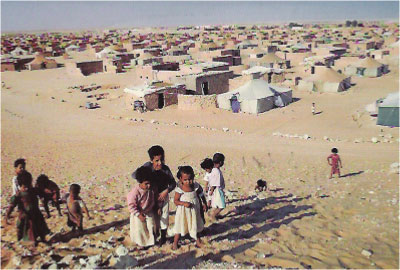For the vast majority of the people, Western Sahara is a territory which can be easily placed in a map due to the same name given to the world’s largest hot desert. But what do we really know about Western Sahara? Through this post we want to focus our interest on the analysis of this territory to reveal those historical facts which are unknown about it.

As is widely known, Western Sahara or the Sahrawi Arab Democratic Republic (SADR) is a territory located on the west of the African continent and it boarders with Morocco on the North, on the Northeast with Algeria and on the East and South with Mauritania. It takes the name of the desert which is part of, the Sahara desert and its largest city is El Aaiún.

Green March, 1975
This stateless nation which is not recognised by every United Nations countries became in the year 1884 a Spanish colony and was treated as Spanish territory until the colonizing country decided to make a referendum on independence to Western Sahara in 1975. But nothing would stop Morocco to achieve its aim of building a huge Moroccan empire. In addition, Morocco had always claimed that Western Sahara was within the country’s borders, and they wanted their territory back. In this way, and a cause of the United Nations’ decision of giving to Sahrawi people the right of self-determination, 350,000 people move towards Saharan territory with the objective of occupying the land. This strategy, known as Green March, will be the beginning of the Moroccan military invasion, and so Spain transferred the sovereignty of the Western Sahara to Mauritania and Morocco in 1976. However, in opposition to the agreement of the administration of the Sahrawi territory, Algeria and the recently created Polisario Front (1973) stood against both Moroccan and Mauritanian claims and demanded full independent of Western Sahara.
Then, Mauritanian and Moroccan troops started occupying the cities of Western Sahara, and consequently, Saharan people were forced to leave the cities and moved to Algerian territory, where they would settle down their refugees’ camps. One of these refugees’ camps is Tindouf.

Refugee camp of Tindouf
When Moroccan troops had already entered the Sahrawi territory, the Polisario Front proclaimed the constitution of the Sahrawi Arab Democratic Republic (SADR) the 26th February 1976, and 3 years later Mauritania signed its peace agreement with the Polisario Front, renouncing their rights to the territory of Western Sahara. However, Morocco, instead of doing the same, annexed the part to which Mauritania had renounced and claimed it as their own while it continued the occupation.
Although nowadays the territory is mostly administrated by Morocco, there is a part of Western Sahara which is controlled by the Polisario Front and it is called the “Free Zone”. It is referred as the zone of freedom because is the only part of Western Sahara which is not under Morocco’s control. Moreover, Moroccan part and Free Zone are divided by the Moroccan Wall, a wall of 2,700km-long that started building in 1980 with the purpose of protecting the territory occupied by Morocco from the intrusion of the Polisario Front as well as of avoiding the return of Saharan refugees.

The Moroccan Wall divides the territory occupied by Morocco and the “Free Zone”
After the abandonment of Mauritania, SADR obtained its greatest international recognition in 1984 and in front of the Organization of African Unity (OAU) in 1982. In September 1991 began the ceasefire guided by UN. However, disputes among Western Sahara and Morocco are still happening, and so its status remains unresolved.
References:
- http://www.saharalibre.es/
- http://en.wikipedia.org/wiki/Western_Sahara
- http://en.wikipedia.org/wiki/Polisario_Front
- http://en.wikipedia.org/wiki/Green_March
- http://hablemosdelsahara.wordpress.com
- http://www.kwang4x4.com/par16.html
Filed under: Blogs and forums, Web Communication Tagged: class activity, free topic post, WCS
![]()